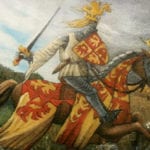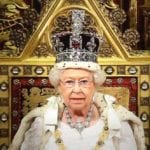 Weird Stuff
Weird Stuff  Weird Stuff
Weird Stuff  Our World
Our World 10 Ways Your Christmas Tree Is More Lit Than You Think
 Movies and TV
Movies and TV The 10 Coolest Stars to Set Sail on The Love Boat
 History
History 10 Things You Didn’t Know About the American National Anthem
 Technology
Technology Top 10 Everyday Tech Buzzwords That Hide a Darker Past
 Humans
Humans 10 Everyday Human Behaviors That Are Actually Survival Instincts
 Animals
Animals 10 Animals That Humiliated and Harmed Historical Leaders
 History
History 10 Most Influential Protests in Modern History
 Creepy
Creepy 10 More Representations of Death from Myth, Legend, and Folktale
 Technology
Technology 10 Scientific Breakthroughs of 2025 That’ll Change Everything
 Weird Stuff
Weird Stuff Ten Bizarre Facts About The Doge Meme
 Our World
Our World 10 Ways Your Christmas Tree Is More Lit Than You Think
 Movies and TV
Movies and TV The 10 Coolest Stars to Set Sail on The Love Boat
Who's Behind Listverse?

Jamie Frater
Head Editor
Jamie founded Listverse due to an insatiable desire to share fascinating, obscure, and bizarre facts. He has been a guest speaker on numerous national radio and television stations and is a five time published author.
More About Us History
History 10 Things You Didn’t Know About the American National Anthem
 Technology
Technology Top 10 Everyday Tech Buzzwords That Hide a Darker Past
 Humans
Humans 10 Everyday Human Behaviors That Are Actually Survival Instincts
 Animals
Animals 10 Animals That Humiliated and Harmed Historical Leaders
 History
History 10 Most Influential Protests in Modern History
 Creepy
Creepy 10 More Representations of Death from Myth, Legend, and Folktale
 Technology
Technology 10 Scientific Breakthroughs of 2025 That’ll Change Everything
10 Times Britain Was Successfully Invaded
There is a widespread myth that Britain has only been successfully invaded three times: by the Romans, the Saxons, and the Normans. (Maybe they were invaded four times, if we count the Nazi occupation of Guernsey during World War II.) Of course, this isn’t true, and today, we’re here to tell you about ten times Britain was successfully invaded.
First, for the sake of clarity: We’re defining a “successful invasion” as an event in which a military group or leader was able to fulfill a set objective on British territory in the British Isles—ideally involving a naval landing, because that’s more exciting.
10 The Roman Invasion
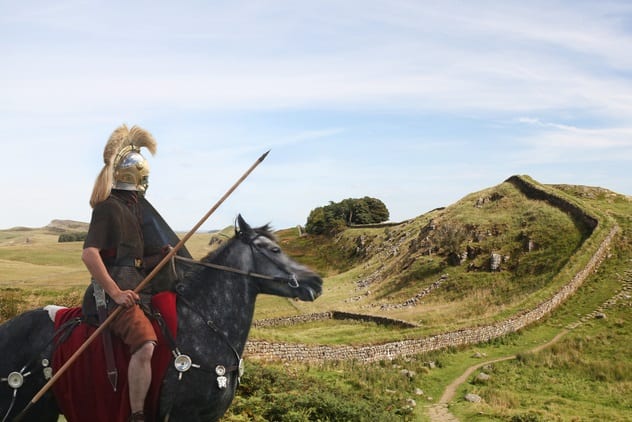
The Romans first landed on the shores of Kent in AD 43 (not counting Julius Caesar’s effort a century earlier). Their conquest ended in AD 84, with the conclusion of Agricola’s campaign. It took six emperors, nine military campaigns, and four decades to fully subjugate England and Wales, and even then, two legions were garrisoned there permanently until the end of Roman rule. British resistance was fierce and long-lived: When Julius Frontinus finished his Welsh campaign in AD 76, he thought he’d brought peace to the region, but when Agricola arrived in AD 78, he had to reconquer the north because the tribes had become independent again.[1]
The tribes lived alongside the Romans for most of their occupation, usually incorporated by diplomatic means. The Catuvellauni were made Roman citizens when their capital was granted municipium status, and they are recorded as helping to rebuild Hadrian’s Wall in the early third century. The Corieltauvi seem to have been allies with Rome; their capital of Ratae was captured in AD 44, but their kings were allowed to continue minting coins in the years following, suggesting that they were allowed to stay independent. These tribes posed a great threat to Rome when relations turned sour: When the Iceni and Trinovantes rose up together, they destroyed the three biggest Roman towns in the country, including the capital.
Even so, the Roman conquest was successful and led to over three centuries of Roman rule, during which time British culture was fundamentally and permanently altered.
9 The Carausian Revolt
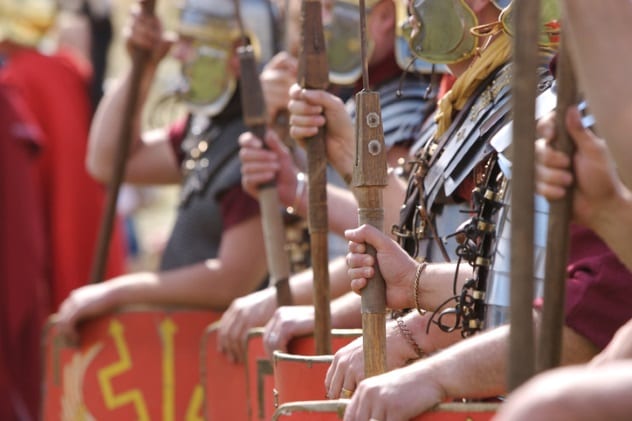
At the time of Constantius I’s invasion (the end of the third century) Rome’s authority was on the wane, and Britain was suffering attacks by Saxon pirates. A man called Carausius, who was the commander of the Roman fleet in Britain, proved himself very capable at protecting the island and became popular—so popular, in fact, that when Rome ordered his execution (apparently because he was seizing goods from pirates for himself), he was able to declare himself emperor of Britain.
Britain was independent from Rome for ten years, seven of which were under Carausius’s rule. He was a classic populist, stamping his coins with phrases like “the golden age is back” and calling himself the “restorer of Britain.” He seems to have enjoyed widespread support, because his name was found engraved on a milestone as far away from London as Cumbria. This support began to wane, however, and his longtime financial advisor, Allectus, arranged Carausius’s assassination and assumed control of his budding empire in 293.
The Roman reconquest began in 296, when the Roman army landed in two separate divisions—one led by the praetorian prefect Asclepiodotus and the other by the emperor himself—sailing from the Seine and from Boulogne. While exact details are sketchy, we can assume that the two divisions landed in different places, perhaps to outmaneuver Allectus and his army. It was Asclepiodotus’s division that ultimately engaged and defeated Allectus.[2] Rebel support collapsed with his death, and Roman rule was restored—but not before they burned down the basilica in London for good measure.
Rome was clearly determined to prevent Britain from becoming a seat of potential rebel power again, because the province was split into five in Diocletian’s reforms just two decades later, and the governor of each province would no longer have control over the local military.
8 The Great Heathen Army
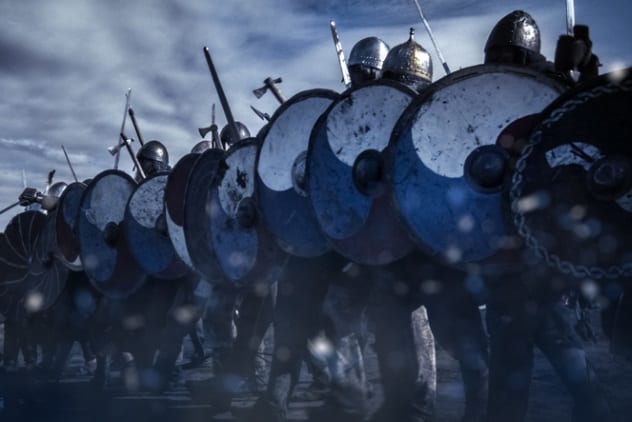
The Great Heathen Army wreaked havoc across Anglo-Saxon England for 13 years, subduing the kingdoms of East Anglia and Southern Northumbria and causing enough damage that, by 877, Wessex was the only Anglo-Saxon kingdom left that could still mount an organized resistance.
They were finally halted by Alfred the Great and his Wessexian army at the Battle of Edington, which led to the Treaty of Wedmore, whereby one of the Viking kings, Guthrum, agreed to become Christian, take an Anglo-Saxon name, and become Alfred’s godson. In return, an official border was agreed between Saxon and Viking England—which mostly followed the route of the old Roman road of Watling Street.
This area of Viking control became known as the Danelaw, and the marks of Viking control and settlement can be seen today in the prevalence of Norse place names in Northeastern England. The Danelaw lasted nearly 100 years, coming to an end when Eric Bloodaxe, last Viking king of York, died in 954.[3]
7 The Norman Conquest
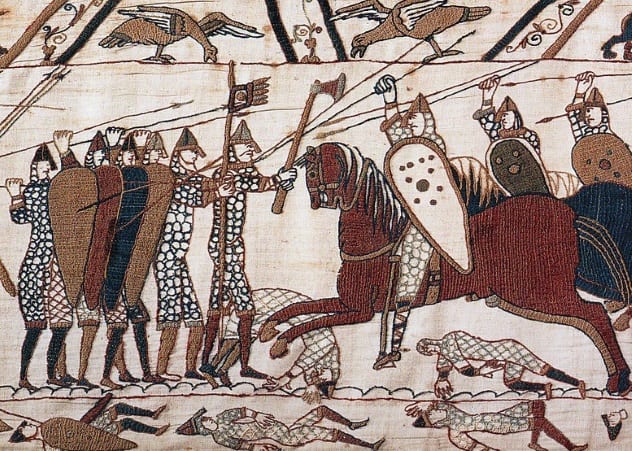
The Vikings also played a big role in William the Conqueror’s invasion a century later, though they certainly didn’t intend to. King Harold of England had just defeated King Harald of Norway outside York when he heard that another claimant to the English throne, Duke William of Normandy, had landed in Southern England. He left some of his army behind and went to meet him, marching long distances each day for a couple of weeks.
He met William’s army at Hastings and was narrowly defeated in a close battle that has since become very famous. He died on the field of battle, though the story of him being hit in the eye with an arrow is likely untrue. Though William was now secure in his legal right to be king—the other two major claimants lying dead—he was by no means secure on the throne and faced almost constant rebellion for the next six years.
William brought the feudal system to medieval England, and he and his supporters built castles across the country to cement their control. He organized the creation of Domesday Book, a register of all the settlements of England, and restructured the tax system.[4] The feudal system came to define medieval England and wasn’t abolished until 1660—almost 600 years after the invasion.
6 Matilda And Henry’s Invasion
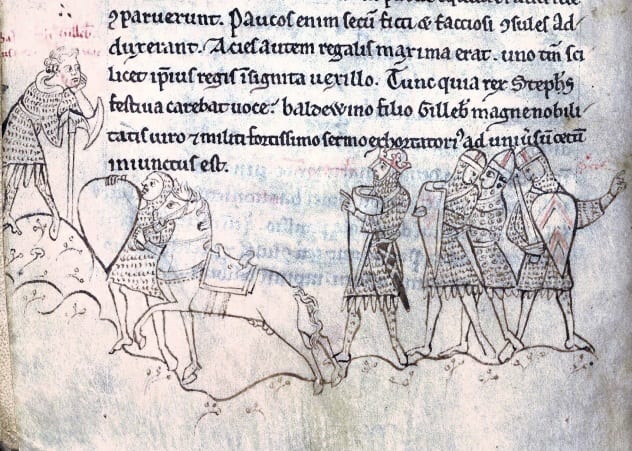
Queen Matilda, sometimes known as Empress Maud, was the person chosen to succeed her father, Henry I. When he died in 1135, however, her cousin Stephen had more support among the barons, so he was able to seize the throne.
Matilda had the support of her half-brother Robert of Gloucester, one of the most powerful men in the kingdom, and he supported her when she tried to assert her claim. A drawn-out civil war began, one which lasted 15 years and would become known as the Anarchy.
Matilda saw some initial success but routinely failed to gather allies or support—she was elected “Lady of the English” in Winchester in 1141 but was driven out of London by the locals when she arrived for her official coronation due to her arrogant personality and demands of money. The war dragged on for over a decade, with both sides struggling to gain the upper hand, even though Matilda herself retired to Normandy in 1148.
The strange war came to an equally strange conclusion when Matilda’s son Henry, who had significant holdings in France, set his sights on England. He sailed over in January 1153, meeting King Stephen’s army on the River Avon later that month. However, the barons on both sides wanted peace and refused to fight. Angered, Stephen agreed to a truce and retreated to London.
The campaign continued for another six months, during which time Henry went around the country making grants and concessions in an attempt to elicit support. King Stephen besieged Wallingford but was forced to retreat when Henry and his army arrived, and both sides once again refused to fight.[5]
A peace was signed shortly after, in which Stephen effectively conceded defeat by agreeing to adopt Henry as his heir and leave the kingdom to him rather than his own heir, Eustace, on his death. This compromise was undoubtedly unsatisfactory to most people involved, not least Eustace, and probably wasn’t intended to be a permanent solution. However, Stephen died just over a year later in October 1154, and Henry succeeded to the throne. The civil war was over, and Henry ruled for 35 years.
5 Isabella And Mortimer’s Invasion
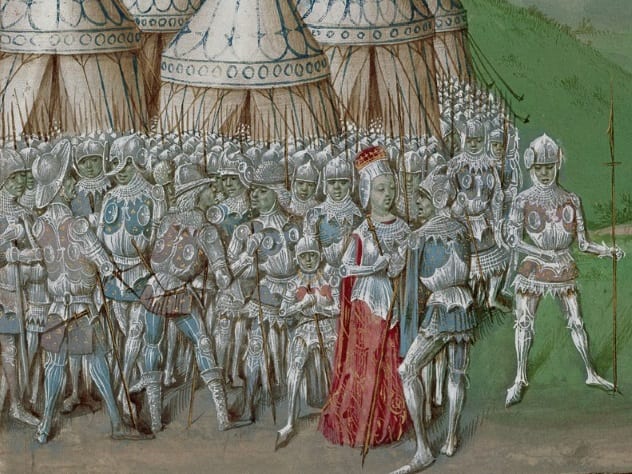
Queen Consort Isabella enjoyed a healthy and normal relationship with her husband, King Edward II, for most of her life. That changed, however, when he sent her on a diplomatic mission to France in 1325. She refused to come home and remained unswayed by her husband’s pleas and threats. The king of France, who was her brother, refused to force her to return. This was a big problem for the British king, especially because she had his son and heir, Edward of Windsor, with her.
By this time, King Edward was controlled by Hugh Despenser the Younger and his father, who were using their influence to extort and bully people out of their lands. The king was wildly unpopular, and Isabella loathed Despenser. She seems to have entered into a relationship with another enemy of the king, Roger de Mortimer. They plotted together to seize the kingdom from Edward, and in September 1326, they landed unopposed in Suffolk with an army they’d raised in Hainault.[6]
Edward originally intended to resist her in London but fled the city some days later when many lords declared their support for Isabella. The campaign was brutally short. Edward fled to Wales with the younger Despenser, apparently hoping to take refuge in the Despenser-held lands there, but he was chased down and captured between Caerphilly and Neath in November, less than two months after the invasion began. He was murdered, and the Despensers were executed.
4 Edward IV’s Invasion
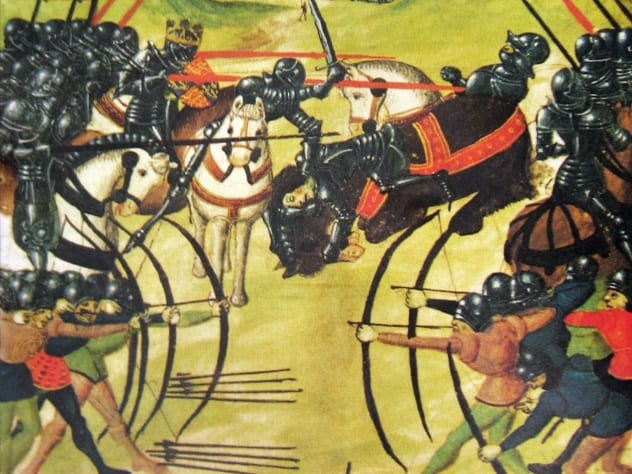
As was the case with most successions during the Wars of the Roses, Edward had to secure his throne by force. A member of the House of York, he and his allies defeated the Lancastrians in 1461. He owed most of his success to Richard Neville, Earl of Warwick, who was the most powerful man in England at the time.
Desperate to secure his throne, Edward set about trying to reduce Neville’s influence, including by marrying Elizabeth Woodville instead of a wife chosen by Neville and the other Yorkist nobles. He also negotiated an alliance with Burgundy while Neville was on a diplomatic mission in France, who were Burgundy’s enemies.
Deciding he’d had enough, Neville switched to the Lancastrian side and, with the backing of the king of France, invaded England in 1470. Quickly supported by most of Southern England and some key figures who switched sides, the Lancastrians took London and proclaimed Edward and his supporters traitors. Edward was forced to flee the realm as Lancastrians returned to England and reclaimed their estates.
However, Edward found support in the King of Burgundy, who gave him supplies and soldiers. He was also supported by Richard, Duke of Gloucester, who had fled with him. They returned to the north of England together and secured Yorkshire, initially claiming that they only intended to recover the Duchy of York.
Supporters flocked to Edward’s banner, and he was able to outmaneuver his enemies and retake London. He met Neville in battle at Barnet shortly after and killed him. However, Queen Margaret landed in Dorset with her Lancastrian troops on the same day, supported by the French, planning to head to Wales, which was sympathetic to the Lancastrian cause.
After a series of grueling forced marches, including one which saw his army cover 64 kilometers (40 mi) in a single day, Edward caught up with Margaret’s army at the Battle of Tewkesbury in 1471, where he crushed the Lancastrians. Nearly all of their leaders were killed in the battle or executed after. The Lancastrians never fully recovered, and Edward was secure on his throne until his death in 1483.[7]
3 The Raid On Mount’s Bay
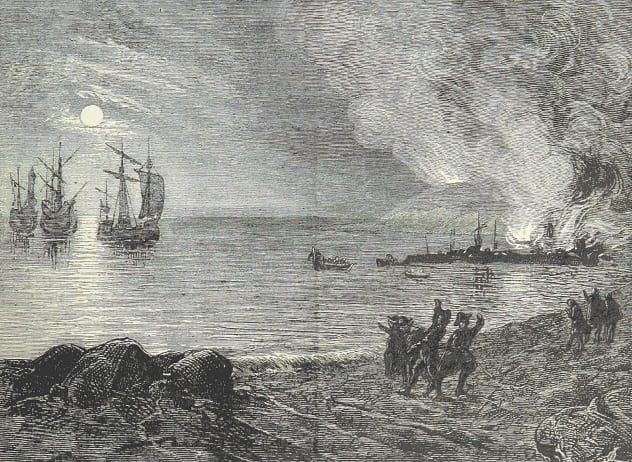
On July 23, 1595, a small Spanish army of 400 men landed in Cornwall. For a nation that prided itself on its naval strength (especially after successfully defeating the Spanish Armada seven years before), this was a disaster in itself for the English. But it was about to get worse.
The town of Mousehole was bombarded from the sea by the Spanish fleet, while the soldiers advanced to the village of Paul and burned it down. Then they moved on to Mount’s Bay itself and sacked and burned the village of Newlyn.
They were finally confronted while on the way to the town of Penzance by the 500-strong local militia, who blocked them at the beach. Threatened by the Spanish ships and the soldiers, who were planning to flank them, the militia fled, and the town of Penzance was sacked. Some 400 houses were destroyed, and the Spanish held Mass at an open-air site nearby; the Spanish leader promised to build a church on the site once England was conquered, which tells us how confident they were.
The local militia began to reform, this time in larger numbers, but the Spanish already had what they came for. They sailed away on August 4, having not lost a man.[8]
Queen Elizabeth was rattled by the raid, and the government organized a nation-wide survey of the country’s defenses, as well as the widespread retraining of the militia of the West Country and a barricading of the local ports. While the country ultimately survived the much bigger armada that came two years later, this was only due to a storm in the Channel. This armada was made up of roughly 14,000 men and could have done considerably more damage.
2 The Raid On The Medway
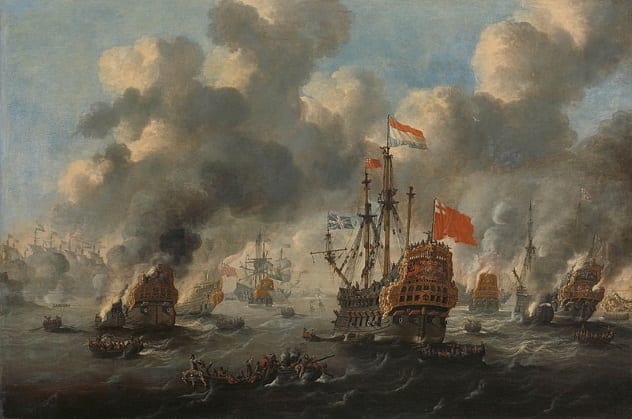
In June 1667, the Dutch fleet sailed up the River Medway to England’s main naval base at Chatham and destroyed 13 English ships before seizing HMS Unity and the pride of the Royal Navy, HMS King Charles. It was the most humiliating naval defeat in English history and had wide ramifications—Samuel Pepys, who was then secretary of the Navy Board, thought it would be the end of the monarchy. The English navy lost three of its four big ships—the other, HMS Royal Sovereign, was only spared because it was in Portsmouth at the time.
The raid itself began with the capture of the fort at Sheerness, which was in the process of being rebuilt. A massive iron chain blocked ships from advancing further down the river, but the Dutch brought it down and defeated the three warships that were guarding it. Three vessels had been scuttled (sunk) across the river to prevent further access, but one sank in the wrong place, leaving a gap for the Dutch fleet to exploit.
The Dutch then came to four of England’s largest ships, including the flagship, the Royal Charles. They seized the flagship, but the other vessels had been scuttled, so they burned the visible parts of these ships to prevent them from being salvaged. With the rest of the fleet secure behind Upnor Castle, the Dutch then chose to retreat with their prizes. Even today, the stern-piece of the Royal Charles is on display in the Rijksmuseum in Amsterdam.[9]
The disaster caused widespread panic in England, especially in London, where many of the wealthy moved out altogether, taking their valuables with them. The government was desperate for peace, and the Treaty of Breda was signed just over a month later.
1 The Glorious Revolution
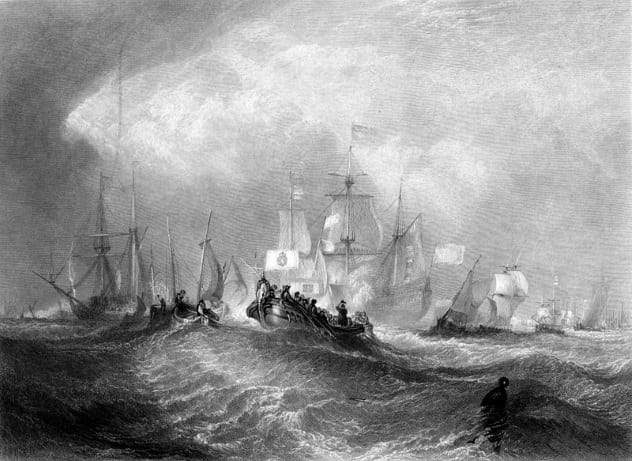
Eleven years after the Medway raid, a Dutchman would take the throne of England after being invited by the country’s own parliament.
James II, the Catholic king of England, had had a son, meaning that the throne wouldn’t pass to his Protestant daughter Mary on his death. The new heir would almost certainly be raised a Catholic by James, risking cementing Catholic rule in England. This was enough to persuade several members of Parliament to write to William of Orange, the Protestant Dutch king of the Netherlands (and Mary’s husband), asking him to intercede.
James had prepared for the invasion, and his army, 25,000 strong, was larger than William’s, but the prospect of William’s invasion had triggered defections and anti-Catholic rioting across the country. James moved his army out of London to meet William in a pitched battle, but he retreated back to the capital before the two forces met.
Ultimately, James realized the futility of his opposition and decided to flee the country.
Parliament originally intended to crown Mary as monarch with William as his consort, but William and his forces pressured Parliament into recognizing them both as joint monarch—for the first and only time in British history. In return, William and Mary signed the Bill of Rights, which serves as the foundation of modern British constitutional practice.[10]
Read about more less-than-stellar events in British history on 10 Of The Most Embarrassing British Military Blunders and 10 Brutal Retaliations Against The British Empire.




